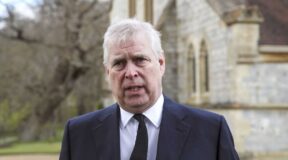Uninterrupted and unrelenting, for eight minutes and 46 seconds, the world seemed to realize what Black people had been talking about for the last century when George Floyd was murdered a year ago by the now-former police officer and convicted murderer Derek Chauvin. They realized why NFL quarterback Colin Kaepernick was taking a knee during the National Anthem. They understood what “Real World” New York original cast member Kevin Powell talked about in 1992 when the series first aired.
In the third month of the nationwide lockdown due to the COVID-19 pandemic, with nowhere else to escape, the majority of the country watched, in real-time, a man struggling to breathe, call out for his dead mother and die under the knee of someone who is supposed to protect and serve. This wasn’t a new entry in the “Faces of Death” movie franchise. This was a Monday.
The entertainment landscape reacted, but it wasn’t just our usual soldiers we expect to hear from, such as LeBron James and Ava DuVernay. Late night hosts like James Corden were being honest about not knowing what to do with this seemingly new feeling saying, “I want to learn more and let that be a start.” Prominent musicians like Harry Styles, criticized in the past by his Black fans for being tepid on racial and political issues, were finally speaking out.
Living in a post-George Floyd world, the gaze in which industry creatives were filming and how the consumers were digesting these pieces of art took on new meanings. Hollywood has, at least on the surface, positioned itself as a haven for story tellers, a home for artists who can express themselves. It’s still unclear if the industry has fully grasped or reckoned with its role that it played (and is playing) is not just the inequality that Black people face but in its depiction of them. While the industry celebrates the achievements and recognition of films such as Steve McQueen’s “12 Years a Slave,” in those intimate parties with wine and cheese, they digest the art as “how it used to be” and not how it is currently.
Shaka King’s “Judas and the Black Messiah” shows police and the FBI hunting and successfully murdering Fred Hampton, the Chairman of the Black Panther Party. Industry executives and viewers watch the Oscar-nominated film and see it as a thing of the past. They fail to see the connection that the same “no-knock” tactic used to murder Hampton is the same utilized by the Louisville Metro Police Department in March 2020 that resulted in the death of Breonna Taylor. Neither of the killings resulted in any government or law-enforcement accountability.
This goes hand-in-hand with films like “The United States vs. Billie Holiday,” showing the singing icon arrested and handcuffed to a bed as she laid dying. Or “One Night in Miami,” depicting a conversation and debate among four prolific Black figures. It all sends a signal to prominent white folks that the Black struggle is over and hasn’t been explored enough by the artists who live them.
The television landscape allowed Michaela Coel to display the gut-wrenching dangers for Black women in HBO’s “I May Destroy You,” which dropped nearly two weeks following Floyd’s death. We even got to see the Emmys pat themselves on the back for finally rewarding Zendaya (for HBO’s “Euphoria”), who became the second Black woman in 72 years to win lead actress drama.
When we lost “Black Panther” star Chadwick Boseman in August 2020, the Black community mourned one of their only positive media symbols we’ve seen in recent memory, echoing the desperate need for more representation for our children and the next generation of artists. The living pioneers of modern cinema — Steven Spielberg and Martin Scorsese — have earned those titles. As they navigate their elder years, they will eventually have to pass the baton to the next generation of storytellers. Spike Lee, our OG in the Black filmmaking space, is by all means still going strong and shows no signs of slowing down. The problem is, how many Black creatives will attempt to “fill the void” after Lee is no longer with us? People will point to greats like Ava DuVernay and Barry Jenkins (and you would be right), but that pipeline for Black filmmakers is much smaller than the ones of our white counterparts.
The legacy of Boseman was so sacred to the Black community, we couldn’t entertain any other actor ever portraying T’Challa in future movies. Think about that and how much the two mean to us — one of the few Black superhero characters, with a large role in the future of the largest franchises in the world, should not be portrayed by any other person because of what he meant to so many. That definition has not sunken in for many who saw the public’s reaction to his passing.

During all of this, we also approached the “Black burnout.” In the entertainment industry and outside of it, companies were inundating their already minuscule pool of Black employees with meetings to “explain” and help them “better understand” racial injustices. Colleagues at work, former classmates, and your white friends were reaching out in Catholicism-like reconciliation to admit privilege, begging to be absolved and “check-in to see how you’re doing with all this.” It was exhausting.
Still, cultural contrarians and insecure white counterparts were throwing asterisks on the cinematic year and writing it off as a “reaction” to Floyd and Black Lives Matter and not a genuine act of progression. Even awards strategists, who spearheaded campaigns for these groundbreaking achievements, were misreading the significance of this social flash and would use the Oscar campaign equivalent of “look, I have a Black friend.”
To add, the same industry that was patting itself on the back for all the “opportunities” it was giving POC was behind the scenes. I remember the day that an AMPAS member, who either forgot or didn’t realize I’m half-Black, said to me there are “too many Black films.” The four or five that were ever in serious contention for the Oscars was “too much” for him to sift through. Instead, he was yearning for the solace of the movies of the old days that didn’t focus on race.
That Academy member’s thoughts are the sentiment Black people often feel after a tragedy by our “allies,” which is a yearning to “return to normal” and not have to face the daily truth of our inequities and shortcomings regarding Black people globally. Hearing versions of the phrases like “it’s all we talk about” or “not everything is about race” are a small sampling of the microaggressions that tend to follow and how these experiences vary from person to person.
For POC, there are still some of us who think this isn’t our problem. Four days before the jury deliberated on the Chauvin trial, bodycam footage showed the shooting of Adam Toledo, a 13-year-old Latino killed by the Chicago police officer Eric Stillman, who was not charged. Pennsylvania Police killed Asian-American Christian Hall, 19, during a mental health crisis and deemed it “justified.” This is all happening amid rising hate crimes in America, with no relief plan in sight.
There’s a moment of perfect encapsulation in Paramount Plus’ “The Real World: Homecoming” season finale that aired in April and was filmed in the middle of the pandemic. Following an argument with his former roommate Becky (who can’t be racist because she’s taken Afro-Brazilian dance classes), writer and activist Kevin Powell, in tears, discusses how his friend Norman has spoken about his painful experience of having his head put in a toilet bowl because he was gay. “I don’t turn the conversation off,” Powell says. “I don’t run away. I have to listen to him. That’s all Black people are saying too. Are you going to listen to us and stop shooting us?”
The aftermath following a tragedy is where the grief is most prevalent. When the cameras go away, and the industry moves on to its next big spectacle, we are left with only our thoughts and open wounds, even if there is a reprieve. Today is hard, just like yesterday, and like it will be tomorrow and the days that follow. We have to be there for one another — listening and learning. That’s the start.
optional screen reader
Read More About:
Source: Read Full Article




